![A complete worldview that is timeless “Spider-Man 2” [Mizumaru Kawahara’s CINEMONOLOGUE Vol.62]](https://cinemore.jp/images/c57afa9f4e4706f148c17e690562359ccec588ed50f82f31710aa61b612e9368.png)
A complete worldview that is timeless “Spider-Man 2” [Mizumaru Kawahara’s CINEMONOLOGUE Vol.62]
It depicts the connection between “dear neighbors” and citizens.

However, I think the most important thing about the Raimi version is Peter Parker's A Very Private Affair. The weight of his role as Spider-Man is strongly felt because the film depicts in detail that he is a sensitive young man before he is Spider-Man. Peter, who is struggling with his double life, is torn between the "great responsibility" and "great power" that Uncle Ben taught him in the previous film.
Peter is so busy with his days as Spider-Man that he doesn't get any college credits, gets fired from his part-time job at a pizza shop, and MJ, who he has feelings for, ends up getting engaged to Jameson's editor-in-chief's son. Peter is seen from all over the city in a perfume advertisement featuring the face of MJ, who just started her career as an actress, but it feels like Peter is becoming more and more distant from her. Eventually, his superhuman abilities begin to decline due to the stress, and Peter finally decides to free himself from Spider-Man and throws away the suit.
On the other hand, Spider-Man's busyness suggests that his presence permeates the city, and what stands out in Raimi's version is exactly the image of Spider-Man as a ``dear neighbor.'' If your spider sense (sixth sense) detects danger, it will change your clothes and rush to the scene, even if you are delivering pizza or on your way to a stage performance where your favorite MJ will appear. People cheer when they see you swinging between them. During his confrontation with the Green Goblin in the first film, New Yorkers even cheered Spider-Man on by throwing things at the Goblin.
In this work, Spider-Man is injured in the fight with Doctor Octopus and despite revealing his true face, he stops the runaway train, but the passengers take care of him and promise to pretend they never saw his true face. Afterwards, the passengers stand in the way of Octopus who comes to deliver the final blow, and the scenes depicting the bond between the citizens and their beloved Spidey are exciting.
The MCU series is certainly interesting and I love it, but I'm also disappointed in the fact that the relationships with these people aren't really depicted (although I understand that they're trying to depict something different). One of the best parts of Raimi's version of Spider-Man is that it depicts both the fight against his archenemy and the bonds he has with the citizens. Crossovers have certainly expanded the world view and even eliminated the gap between films, but at the same time, the story has spread out and feels like it has stretched out, whereas there are some stories that are completed within a single work. (Obviously), it tightens up, and there's something about it that makes me feel relieved.
I don't know yet whether the Doctor Octopus that appears in "No Way Home" is connected to Raimi's version (I can't believe I forgot about Quicksilver in "WandaVision". In any case, ``Spider-Man 2'' and the characters and story depicted in it will continue to be the standard for Spider-Man movies.
Illustrations and text: Mizumaru Kawahara
Born in 1991. Illustrator. In addition to illustrations and covers for magazines and books, there are also illustration columns for movies and books.

